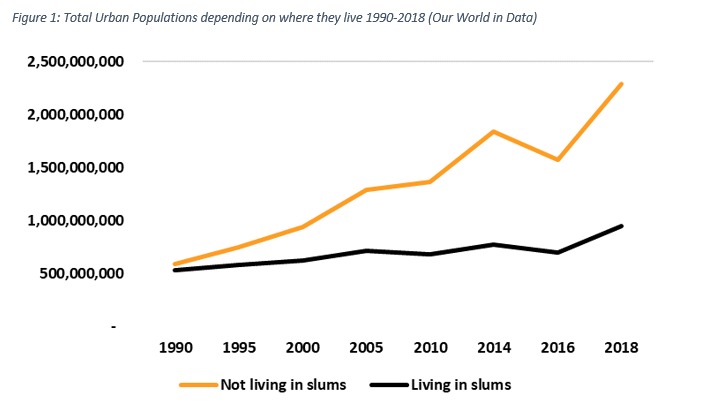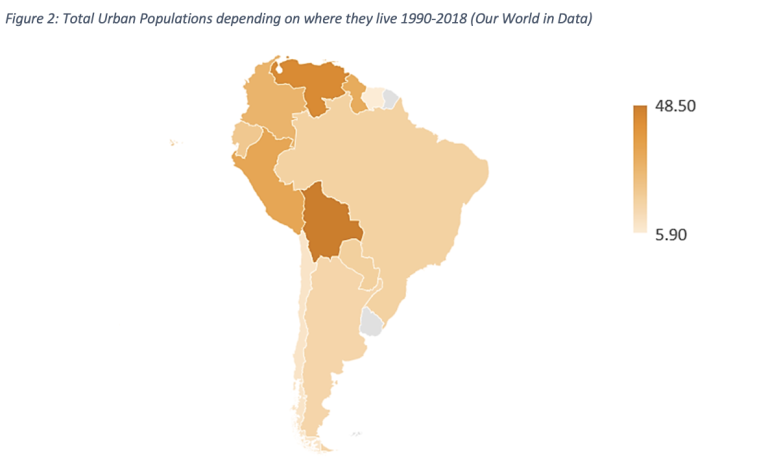“Sustainable Cities and Communities” in South America
 Adam MacRae
Adam MacRae  March 1, 2023
March 1, 2023  Adam MacRae
Adam MacRae  March 1, 2023
March 1, 2023 As we shift our attention to South America and the 11th Global Goal of Sustainable Cities and communities for this month’s briefing, let’s remind ourselves of the importance that cities play in our lives. Because meeting the Global Goals depends heavily on making cities function properly.
To highlight just how important cities are and the outsized role they play in shaping the world, consider a few numbers:
For this briefing, the specific target is ‘adequate, safe, affordable housing and basic services and upgrading slums’. This is a particularly important ambition because not only are cities growing rapidly, but 90% of the growth of urban centres that will occur in the coming decades will be in developing countries. If cities can’t keep up with the demands of rising populations, there is a risk that slums will continue to expand.
Within the span of a generation, we are still witnessing leaps and bounds in the growth of cities. In 1990, there were ten mega-cities with 10 million inhabitants or more. In 2022, there were 33 cities with a total population of 528.9 million. South America is also well represented: Bogota, Buenos Aires, Lima, Rio de Janeiro, and São Paulo all making the list.

However, as Figure 1 shows us, while urban areas have dramatically increased over that time, the population living in slums have been a tricky point to address. As of 2020, more than 1 billion people lived in slums or informal settlements, of which 84.5 million live in South America, which is larger than the population than Germany.

Like other regions in the world, South America is home to a large and diverse population with the rates of those living in urban slums varying wildly across the continent. Bolivia has the highest rate at 48.5%, while Suriname has the lowest with 5.9%. Brazil, with two mega-cities of its own, and home to arguably the most famous slums in the world, favelas, has a rate of 16.3%.
Aside from the obvious, it is important to highlight the adverse effects of slum living and communities.
While there are many issues related to slums, fixing those living conditions could unleash untold benefits for the people living there and the wider community. Below are two solutions to help tackle the problem.
First, build more homes. People need somewhere to sleep and they will build with or without permission. The more affordable homes there are, the more we can address housing needs. This will require a combination of updated policies on behalf of cities to free up more land for development, as well as financing and developer support. An added bonus would be ensuring that these homes are built with a changing climate in mind and developed in a way that are not only low in CO2 emissions, but energy efficient and reduce future energy demand of a growing populace.
Second, invest in infrastructure. This will require a sizable amount of capital. For example, research done by UN Habitat in collaboration with Aid Data found that a city such as Medellin would require $1.3 billion in transportation for a city of 2.5 million. This is not impossible and would not be the first time Medellin led the way. In 2004, the city came to fame with the development of its now famous cable-car system. The Metrocable was an affordable alternative that helped previously disconnected residents in outer slums to have easier access into the city. Studies also showed strong relationships between the creation of the Metrocable system and reductions in crimes where the stations were made.
These are just two examples of investing in real estate and infrastructure that help support a brighter and more sustainable future. If you would like to learn about how Holocene can support your infrastructure or real estate projects, get in touch with our Chief Sustainability Officer at info@holoceneic.com